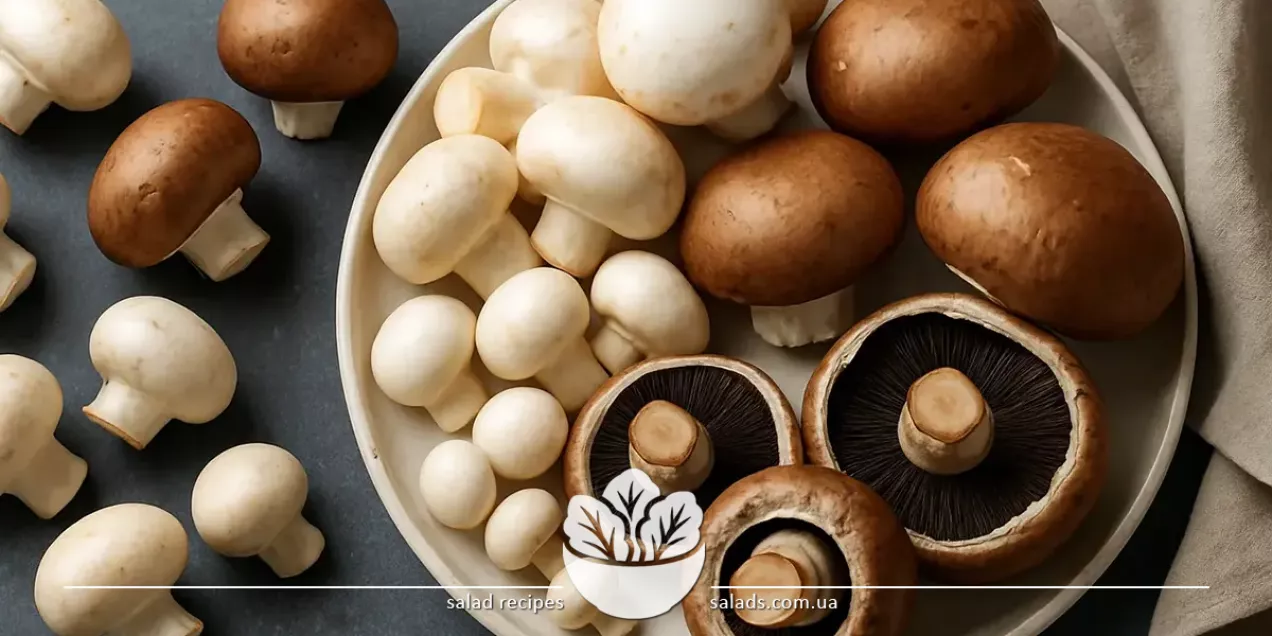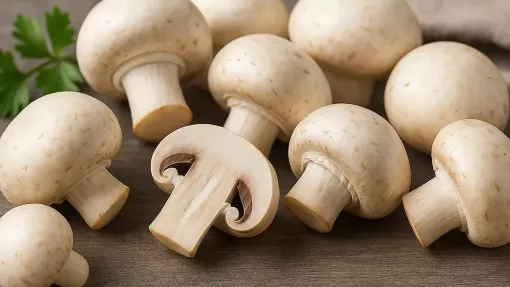Types of Champignon Mushrooms

Types of champignon mushrooms include several varieties of this popular edible fungus, which has become an essential ingredient in global cuisine. With a mild aroma, pleasant texture, and quick preparation time, champignons are a universal component for meals of any complexity – from breakfast to dinner. They pair well with meat, vegetables, grains, and sauces, offering excellent flavor flexibility. Within the mushroom category, champignons hold a leading position due to their ease of cultivation, availability, and variety of forms. Depending on the type, they can vary in density, aroma, and culinary purpose, allowing everyone to find the ideal mushroom for their favorite dish.
Different Types of Champignons
Diverse Champignon Varieties
Champignons are not just one type but include several varieties that differ in appearance, aroma, and culinary function. The most common are classic white champignons – mushrooms with a soft cap, delicate flavor, and light texture. They are widely used for frying, boiling, stewing, baking, and even raw – for example, in salads. Their neutral aroma allows for experimentation with sauces and spices, creating new flavor combinations. Brown champignons (sometimes called cremini or “champignon crema”) have a denser structure, deeper mushroom flavor, and hold their shape well during cooking. They are ideal for casseroles, stews, stuffed meat rolls, and meat side dishes. These mushrooms are often added to dishes with beef, where their rich aromas create true culinary harmony.
Royal champignons (Portobello) are large mushrooms with a meaty texture and rich flavor, perfect for baking, grilling, or stuffing. Their size makes them suitable for use as a base for fillings or even as “mushroom steaks.” These mushrooms are especially popular in vegetarian dishes, where they serve as a meat substitute due to their density and intense taste. All types of champignons pair well with other ingredients – whether fresh or cooked. They are suited for salads, soups, pizzas, pies, sauces, or served as a standalone dish. Thanks to their low calorie content and rich vitamin and mineral profile, champignons have become a staple of healthy diets.
Nutritional Value and Health Benefits
Champignons offer a valuable chemical composition that makes them an important part of a balanced diet. They contain about 2-4 g of protein per 100 g – not much, but it is easily digestible and includes all essential amino acids. They are also rich in B vitamins (B2, B3, B5) and minerals such as potassium, phosphorus, iron, copper, and selenium – micronutrients that support nervous, cardiovascular, and immune system functions. Another advantage is their low calorie content (only 22-27 kcal per 100 g), minimal fat, and zero cholesterol. With more than 90% water content, mushrooms provide satiety without burdening the digestive system.
The fiber in the caps and stems improves digestion and helps regulate blood glucose levels. Champignons may have antioxidant properties – especially brown and royal varieties, which contain more polyphenols. Including mushrooms in the diet regularly can positively impact metabolism, skin health, and overall well-being. Notably, mushrooms combine well with a wide range of foods. For example, lightly sautéed champignons pair perfectly with seafood, including shrimp, offering a harmonious blend of protein and aroma. This allows them to be used not only as a side dish but also as a substantial main course.
Culinary Uses of Champignons
Champignons are a true gift to cooks. They can be boiled, fried, stewed, baked, pickled, dried, or eaten raw. Thanks to their delicate taste, they are ideal for soups, side dishes, appetizers, and salads. Creamy mushroom soups are especially popular – with a velvety texture, deep flavor, and minimal ingredients. Another classic option is julienne in a cream or cheese sauce. Fried champignons are a versatile base for pasta, pizza, omelets, or stews. For breakfast, they are often combined with eggs, herbs, and vegetables. In salads, raw or lightly sautéed champignons pair well with apples, cheese, and nuts – a common combination for light meals.
Baking is one of the best ways to bring out the flavor of royal champignons. They can be stuffed with ground meat, vegetables, grains, or cheese. Such mushrooms work well as a main dish or appetizer. For grilling, large caps are ideal – lightly brushed with oil, seasoned, and served as “mushroom steaks.” Pickled champignons are a favorite snack in many cuisines. They remain crunchy and store well. They can be served as a side dish, salad ingredient, or festive appetizer. Combinations of champignons with pickled vegetables, cheese, or cucumbers are especially appealing. Thanks to their versatility, champignons have become a staple ingredient in everyday cooking – they can be added to nearly any dish to make it more flavorful, hearty, and interesting.
How to Store Champignons Properly
Champignons have a delicate structure and must be stored carefully to avoid spoilage and loss of aroma. Fresh mushrooms should be kept in the refrigerator at +2…+4 °C. Ideally, they should be stored in a paper bag or an open container, which allows them to “breathe” and prevents moisture buildup. In plastic containers or sealed bags, champignons darken and spoil more quickly. The best shelf life for fresh mushrooms is up to 3 days. After that, they lose firmness and aroma and may start to spoil. For long-term storage, they can be dried, pickled, or frozen. Freezing is recommended only after blanching or pre-sautéing – raw mushrooms become watery and lose structure after thawing.
Dried champignons should be stored in airtight jars or cloth bags for up to a year. They are suitable for making broths, sauces, and casseroles. Before use, dried mushrooms should be soaked in water for 15-30 minutes. Pickled champignons can be stored in the refrigerator for up to 2 weeks in glass jars with vinegar solution. When cooking with mushrooms, additional ingredients are often used to balance the flavor. For example, champignons in lemon juice sauce gain freshness and a pleasant acidity – a popular combination in Mediterranean cuisine. Mushroom dishes paired with grains, cheese, or vegetables make for complete main meals.
Champignons in Healthy Eating
Champignons are an excellent choice for those following a healthy lifestyle. They can be confidently included in the diets of vegetarians, athletes, children, and people with dietary restrictions. Thanks to their low calorie content and high fiber, mushrooms help regulate weight, improve digestion, and maintain stable blood sugar levels. Importantly, champignons are one of the few plant-based foods that contain ergosterol – a precursor of vitamin D. With heat treatment or sun-drying, this compound converts into the active form of the vitamin, which is especially useful in winter or when sun exposure is limited.
In healthy diets, champignons are often used as a meat substitute in various dishes. Their firm texture makes it easy to prepare nutritious but light lunches and dinners. For example, stewed champignons with grains or vegetables form a complete meal rich in minerals and fiber. For snacks, sandwiches with mushrooms, greens, cheese, and toast work well. Adding mushrooms to different recipes is not only delicious but also practical. Thanks to their versatility, champignons can replace or complement many ingredients. For example, a vegetarian pasta with mushrooms and beef for meat-eaters, or with tofu and cheese for a lighter version. In any case, champignons enrich the dish with flavor and nutritional value.
